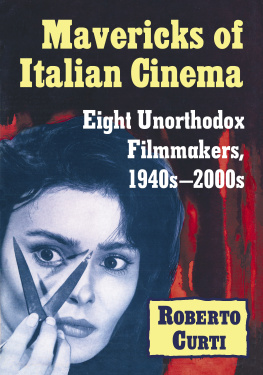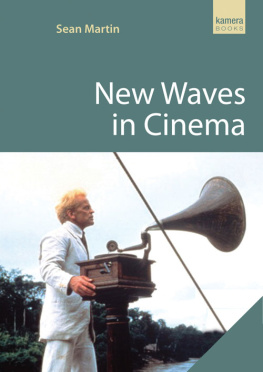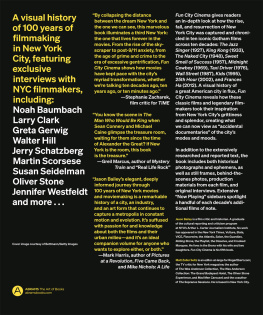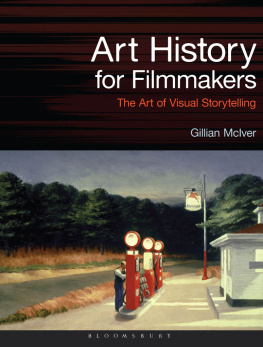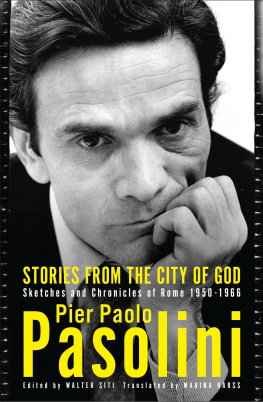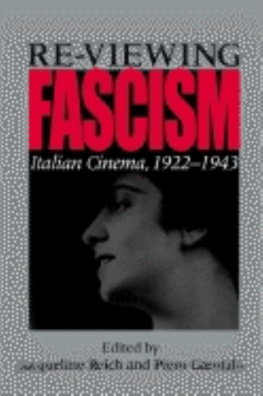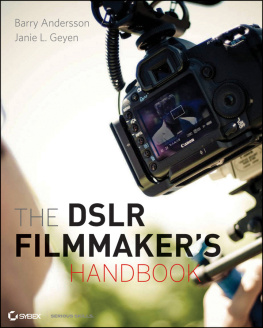
Also by ROBERTO CURTI
AND FROM MCFARLAND
Bracali and the Revolution in Tuscan Cuisine (2018)
Riccardo Freda: The Life and Works of a Born Filmmaker (2017)
Italian Gothic Horror Films, 19701979 (2017)
Tonino Valerii: The Films (2016)
Italian Gothic Horror Films, 19571969 (2015)
Italian Crime Filmography, 19681980 (2013)
Mavericks of Italian Cinema
Eight Unorthodox Filmmakers, 1940s2000s
Roberto Curti

McFarland & Company, Inc., Publishers
Jefferson, North Carolina
LIBRARY OF CONGRESS CATALOGUING DATA ARE AVAILABLE
BRITISH LIBRARY CATALOGUING DATA ARE AVAILABLE
e-ISBN: 978-1-4766-3300-8
2018 Roberto Curti. All rights reserved
No part of this book may be reproduced or transmitted in any form or by any means, electronic or mechanical, including photocopying or recording, or by any information storage and retrieval system, without permission in writing from the publisher.
Front cover: French sales flyer for the 1963 film Il demonio (courtesy Lucas Balbo)
McFarland & Company, Inc., Publishers
Box 611, Jefferson, North Carolina 28640
www.mcfarlandpub.com
To my dear friend
Tommaso La Selva
Acknowledgments
I would like to thank the following, who in one way or another helped me during the making of this book: Lucas Balbo, Davide Cavaciocchi, Francesco Cesari, Pierpaolo De Sanctis, Alessio Di Rocco, Steve Fenton, Mario and Roderick Gauci, Peter Jilmstad, Stefano Lecchini, Antonio Marchesani, Paolo Mereghetti, Domenico Monetti, Alberto Pezzotta, Roberto Poppi, Massimiliana Spinola, Marco Vanelli and Camillo Vegezzi.
A Note on the Essential Filmographies
The Essential Filmographies at the end of each chapter do not include short films. Story and script writing credits include significant contributions to the story or screenplay, either credited or uncredited. Films are listed chronologically by release date.
Abbreviations
Co-DCo-director
DDirector
PProducer
SStory
SCScreenplay
Introduction
Like a turbulent river fed by numerous tributaries, the history of Italian cinema in the second half of the 20th century is seething with undercurrents. PostWorld War II Italian cinema, as seen from a foreigners perspective, is usually broadly divided into two big categories: auteur and genre films. On the one hand, there are the works of the big-name directors: Rossellini, De Sica, Visconti, Fellini, Pasolini, Antonioni, etc. On the other, those movies designed for mass consumption: the sword-and-sandal, the Gothic, the spy thriller, the Western, gialli, crime films, up to the many threads that by the mid- to late 1970s took turns chaotically, from the cannibal movie to the zombie film. Some genre directors have in turn gained auteur statusSergio Leone and Dario Argento, to name two. They offered films which adhered to the rules of the Western and thriller genres respectively, but in the meantime they deeply innovated said rules, paving the way for new threads and dozens of similar productionsor hundreds, in the case of the EuroWestern fever.
If auteurs brought the national production to the attention of foreign audiences and won prestigious awards, it was with the development of genres that the Italian industry found a profitable market abroad. From the late 1950s onward, an enormous number of works were designed not only for the home consumption but for export as well, until finally, in the 1980s, the industry virtually collapsed under the weight of the economic crisis it had been fighting during the previous decades, and gave way to the soft tyranny of television.
Like most simplifications, such a distinction leans on shaky foundations. It is illusory to think that the dichotomy between auteur and genre would cover the whole spectrum of a film industry that developed with an outstanding vitality after World War II. And yet, over the years this contraposition has increased dramatically.
With the birth of home video, in the early 1980s, a different type of cinephilia was born, based on aesthetics and ways of fruition different from the experience of moviegoing. Instead of physically going to the theater, film buffs would invest their time and money in videotapes, purchasing or swapping them with other collectors. For these cinephiles, the common goal was to dig deeper, often via a thick net of contacts all over the globe. Many films and filmmakers were thus exhumed to visibility, and as with other foreign filmographies, the cult aura that surrounded the exotic Italian cinema spread over an increasingly wider number of items and figures. The result was a blossoming of fanzines and magazines put together by a legion of enthusiastic fans: they were crammed with reviews, interviews, retrospective articles, dictionaries, and comparisons between home video versions. It was a new generation of critics who wrote first and foremost about the films that they owned physically and idolized like fetishes.
In turn, with the birth and development of the Internet, countless newsgroups, forums, blogs, webzines and websites have taken over; meanwhile, over the past two decades, genre film studies have increased exponentially, whether they be monographies on individual directors or volumes devoted to a particular genre.
This gold rush of sorts had many positive aspects, not least the growing awareness of a valuable heritage of the past, in contrast with contemporary mainstream cinema perceived as hollow and uninteresting. It also allowed visibility to films that had been neglected in their home country, and to a fair reassessment of the qualities of genre production, as opposed to the biased and dismissive attitude of old-style critics.
But this reappraisal was not devoid of flaws either. In fact, it was often permeated by an auteurist approach, oblivious of the historical, cultural and economic context and conditioned by a strong anti-intellectualistic component, paired with an emphasis on some characteristics (such as shock value, for instance) and utter disregard for others. Similarly to what had happened with the most iconoclast French cinephiles in the 1950s, the main goaleither conscious or unconsciouswas basically to overthrow the current aesthetic canons and build an alternate cinema history in which the obscure and the reviled would finally find their place in the limelight.
In the case of Italian cinema, this has led also to misleading and reductive labeling, mostly based upon a films alleged belonging (or not belonging) in a genre. Moreover, some areas were often left out by foreign studies, namely those products devised for national audiences but less suited for export due to their characteristics: think of comedy, which relies heavily on dialogue and on elements (socio-political satire, depiction of regional types and mores, etc.) which are difficult to appreciate outside their country of origin.
But things, in Italian cinema and elsewhere, are never quite black or white, and they often inhabit a grey area whose boundaries are indistinct and deceptive. The perfect metaphor could be the image of David Hemmings developing the photograph he has taken in Blow-up (1966), and realizing that, the more he blows up the image, the less he is sure of what exactly it depicts, as shapes and contours become blurry.
Next page
